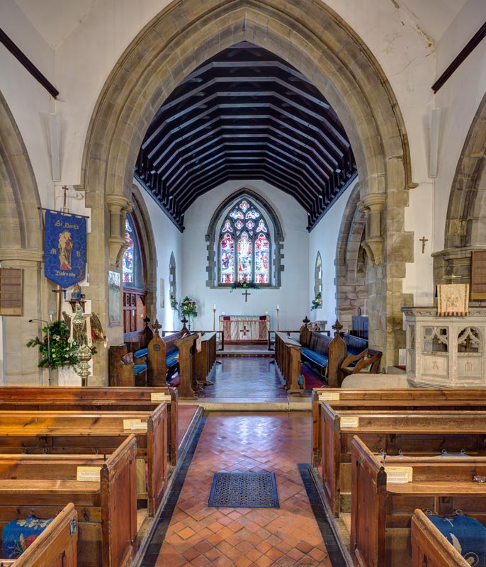Balcombe – St Mary
A small church, probably of C13 origin, with a C15 tower. Following enlargement and in large measure rebuilding in 1847 and 1872, the old church is now the south aisle.
Two C19 extensions have obscured the original ground plan of the church and the use of the various parts. The oldest parts are the long and narrow former nave and the chancel, which were originally aisleless and are probably C13, though both were entirely refaced in the C19 in the same local stone as previously. Horsfield noted lancets in the south nave (I p260) and the broad internal splays of a single-light traceried C19 window, which may be original in form at least, would suggest a date relatively late in the century. The C19 east window has tracery like the C14 one at Ardingly, but as it was blocked in the early C19 (ibid) and Nibbs (c1851) shows it already restored, it cannot be ascertained whether this represents the original form. C15 alterations included a three-light south nave window with a depressed head, which has been accurately renewed, and the tower, which is almost as broad as the nave and has a shingled broach spire. Its uncusped lights and long two-light square-headed west window show it is late C15, as does the tower arch of two continuous chamfered orders. Though much renewed, the tower is little changed in appearance from the Sharpe Collection drawing (1805). This also shows a large two-storey south porch of uncertain date with a half-hipped roof, which has been replaced by a stone one.
The present appearance of the church, built of local sandstone, is C19, though its development during that period was not straightforward. First came a restoration by H Clutton in 1847 (WSRO Par 234/4/3). In addition to renewing and altering the detail of the existing nave and chancel, with a west gallery (ICBS), he added a large gabled north aisle at a cost of £1400 (Nibbs, Notes of 1851), with a three-bay arcade with double-chamfered arches and octagonal piers. As often happened in this part of Sussex, he kept the Horsham slabs on the roof of the nave which is otherwise all C19 with tiebeams. Clutton’s new aisle (now the nave) has a braced roof.
Many churches were extended in this way in the C19, but a second restoration by E Christian in 1872-73 (WSRO ibid) further obscured earlier development. Clutton’s north aisle was turned into the nave by adding a new aisle to its north and a chancel. The latter has an arch enriched with stumpy double shafts of marble. The old church became the south aisle and the former chancel a chapel opening into the new one. To make the new nave a unity, Clutton’s south arcade was copied on the north side, though in the absence of a tower it has four bays. As a consequence, the groundplan is almost square. Christian’s aisle has a trussed roof which differs from the others.
No obvious trace of repairs in 1948-50 by H M Pett (ICBS) can be seen. Since that time the main change has been new cupboards at the west end and glass doors, designed by J Jones-Warner Associates (architect’s website).
Fittings:
Chest: C17.
Font: Octagonal bowl with a quatrefoil on each side, installed in 1847.
Glass:
1. (South west nave window near the font). C17 Flemish panel of the Crucifixion.
2. (North aisle, west window) T Willement, c1852 (signed) with characteristically bright colours. The total cost was £27 1s 0d (Willement Ledger). Though there is no record of its authorship, the east window of what is now the south aisle could also be by Willement.
3. (North aisle, second window) J Hardman and Co, c1873 (Index). It is badly faded.
4. (North aisle, third window) R Grimshaw,1994 (signed). A Virgin and Child with intense colouring.
5. (North aisle, fourth window): J Hayward and M Noble, 1995 (signed). Largely heraldic in nature.
Painting: (At west end of nave) Stencilled Annunciation in muted colours, set in a broad decorative border. Painted and signed by R Smith and D Verulam, 1987
Pews: The ones in the central nave only have low.doors and are likely to have been installed by Clutton, though he would surely have deplored such a low church feature in view of his increasingly Catholic sympathies.
Reredos: (formerly) 1847, enlarged in 1872 with a centre panel of marble, alabaster and mosaic. (B 31 p552).
Source
1. D H Turner: The Parish Church of St Mary, Balcombe, 1968
Plan
Schematic plan in 1. inside cover
My thanks to Mike Anton for the photographs except the exterior from the south east and the Willement glass.






